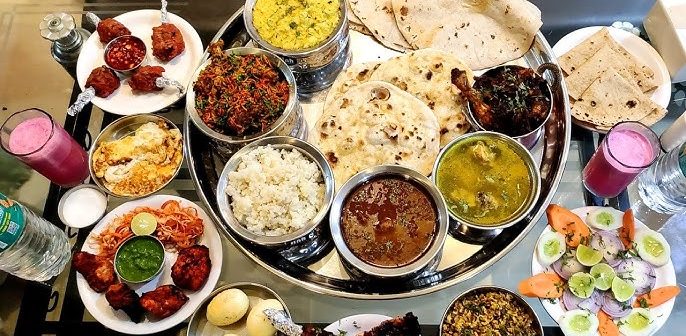The Indian thali is more than just a meal; it is a culinary representation of India’s rich cultural tapestry, showcasing the diversity and complexity of its regional cuisines. A thali offers a harmonious assortment of flavors, textures, and nutrients, all meticulously arranged to provide a balanced and satisfying dining experience. This comprehensive exploration delves into the origins, history, evolution, components, and cultural significance of the Indian thali.
Etymology and Definition
The term “thali” originates from the Hindi word for “plate” or “tray.” In the context of Indian cuisine, it refers to both the physical platter and the style of meal presentation that includes a variety of dishes served together. Traditionally, a thali is a round metal plate, often accompanied by small bowls called “katoris,” each containing different food items. This arrangement allows diners to sample a wide array of flavors and dishes in a single sitting.
Historical Origins
The concept of the thali can be traced back to ancient India, where communal eating was a common practice. Historical evidence suggests that during the Vedic period, meals were served on plantain leaves, and the use of small bowls, or “dunas,” was prevalent. These early dining practices laid the foundation for the thali’s structure, emphasizing portion control and a balanced assortment of dishes. Over time, the thali evolved to reflect social hierarchies and cultural norms, with variations in portion sizes and dish selections based on factors such as social status, regional customs, and dietary preferences.
Evolution of the Thali
As Indian society evolved, so did the thali. The introduction of metal plates and bowls replaced the traditional plantain leaves, and the variety of dishes expanded to include a broader range of flavors and ingredients. Regional influences played a significant role in shaping the thali, with each area developing its unique version that highlights local produce, spices, and culinary techniques. The thali became a canvas for showcasing regional specialties, seasonal ingredients, and traditional cooking methods, resulting in a diverse array of thali styles across the country.
Components of a Traditional Thali
A traditional Indian thali is designed to offer a balanced meal that satisfies all the taste buds. While the specific components can vary based on regional and cultural preferences, a typical thali includes:
- Grains: Staples such as rice or flatbreads like roti, naan, or chapati provide the carbohydrate base of the meal.
- Lentils and Pulses: Dishes like dal (lentil soup) or sambar (a lentil-based vegetable stew) offer protein and fiber.
- Vegetables: A variety of vegetable preparations, ranging from dry stir-fries to rich curries, contribute essential vitamins and minerals.
- Condiments: Chutneys, pickles, and raita (a yogurt-based side dish) add flavor contrasts and aid digestion.
- Savories: Items like papadum (crispy lentil wafers) or fried snacks provide a crunchy texture.
- Sweets: A dessert, such as kheer (rice pudding) or gulab jamun (sweet milk-solid balls), offers a sweet conclusion to the meal.
This assortment ensures a harmonious blend of sweet, sour, salty, bitter, pungent, and astringent flavors, aligning with the Ayurvedic principles of balanced eating.
Regional Variations
India’s vast geography and cultural diversity have given rise to numerous regional thali variations, each reflecting local tastes, ingredients, and culinary traditions. Some notable examples include:
- North Indian Thali: Often featuring rich and hearty dishes, a North Indian thali may include items like paneer butter masala (cottage cheese in a creamy tomato sauce), chole (spiced chickpeas), aloo gobi (potato and cauliflower curry), along with naan or roti, rice, raita, and a sweet like halwa.
- South Indian Thali: Typically served on a banana leaf, this thali emphasizes rice-based dishes and includes sambar, rasam (a tangy tamarind soup), poriyal (stir-fried vegetables), appalam (crispy wafers), and payasam (a sweet pudding).
- Gujarati Thali: Known for its vegetarian fare and a balance of sweet and savory flavors, a Gujarati thali might feature dishes like dhokla (steamed fermented rice and chickpea batter), undhiyu (mixed vegetable curry), kadhi (yogurt-based curry), puri (fried bread), and sweets like shrikhand (sweetened yogurt).
- Rajasthani Thali: Reflecting the arid climate of the region, this thali includes dishes that utilize dry ingredients and spices, such as dal baati churma (lentils with baked wheat balls and sweetened crushed bread), gatte ki sabzi (gram flour dumplings in curry), and ker sangri (dried berry and bean curry).
- Bengali Thali: Highlighting the region’s love for fish and mustard, a Bengali thali may comprise items like shorshe ilish (hilsa fish in mustard sauce), aloo posto (potatoes in poppy seed paste), bhaja (fried vegetables), rice, and mishti doi (sweetened yogurt) for dessert.
Each regional thali offers a unique culinary experience, reflecting the local culture, climate, and agricultural practices.
Cultural Significance
Beyond its culinary appeal, the thali holds deep cultural significance in India. It embodies the principles of hospitality, community, and balance. Serving a thali to guests is considered a gesture of respect and warmth, symbolizing abundance and the host’s desire to offer a complete and satisfying meal. In many Indian households, the thali is an integral part of festivals, weddings, and special occasions, reinforcing social bonds and cultural traditions.
The thali also reflects the Indian philosophy of balance and harmony, not only in flavors but also in nutrition.





